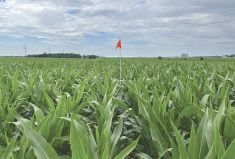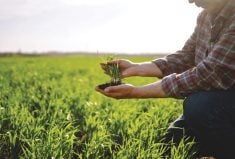Open just about any U.S. farming publication and you won’t read for long before seeing the words “cover crop.” There’s been an explosion of interest in the practice of sowing a cheap mixture of seed to cover the soil after harvest, and then seeding directly into it the following year.
The benefits go beyond soil conservation alone — recent survey reports say that U.S. corn yields rose an average of 8.3 bushels per acre, and soybeans 2.4 bushels per acre, in fields after four years of cover cropping.
Read Also

Agronomists share tips for evaluating new crop products and tech: Pt. 3
With new products, new production practices and new technology converging on the agriculture industry at a frenetic pace in recent…
That may be fine for the U.S. Corn Belt where there’s more time to get the cover crop established and growing, but does it make sense for short-season Western Canada?
Well, recently the seasons aren’t as short as they used to be, and they tend to be wetter, leaving farmers wondering what to do with all that excess moisture.
That’s just one reason why cover crops might make sense, says Yvonne Lawley, a cropping systems researcher at the University of Manitoba.
“We’re in a new time, and agronomists are getting a lot of questions from farmers about cover crops,” Lawley told the Manitoba Agronomists Conference last December. “Farmers are returning to this old practice for new reasons.”
Cover crops are being used as green manure for organic production, as catch crops to prevent nutrient leaching, to improve soil organic matter and nutrient cycling, break up hardpan, protect soils from erosion and to increase the productivity of grazing systems.
But Lawley said the soil health benefits of cover crops go beyond those traditional objectives.
“If we think about the whole chain of microbes that exist in soil, they’re really being fed by the inputs and cycling of nutrients within the agro-ecosystem. If we can have plants growing for a longer period of time, capturing more sun, we can provide more input through either organic matter or exudates from roots that feed the fungi, bacteria and nematodes that then feed the higher trophic structure like earthworms.”
The recent shift in thinking is about when this activity occurs during the season.
“We are now thinking about the shoulder season as our period of intensification, and what we are going to do with that period before we seed our crops and after we harvest them in the fall,” Lawley said. “We have other crops and other windows where we can think about how to intensify our use of those resources to feed this soil food web.”
Cover crop fundamentals
There are a few fundamentals for producers to consider before trying cover crops. They need to know their objectives, the available window to grow a cover crop, and the same basic agronomic information they would use to decide their cash crop mix.
“There may be a number of different objectives that a farmer could have,” Lawley said. “They range from very short-term goals such as preventing erosion or fixing N to long-term goals such as improving water infiltration or extending the grazing season.”

Farmers need to know if they can fit cover crops within their current rotation, Lawley said, or whether they want to change the rotation to include a cover crop.
For example, producers dealing with wet soils in the spring could intentionally plant early harvested crops to provide a longer window of opportunity for planting cover crops to overwinter and transpire water to help dry the soil the following spring.
“Some of those early harvested crops are vegetable crops,” Lawley said. “We have a range of crops that allow us to have a good, sizable window especially with the increasing length of the fall. We often get a frost in early September but then go on to have good growing conditions in September and much of October.”
To plan a cover crop, producers and agronomists need to consider the usual agronomic information, such as crop rotation, tillage system, soil types, drainage and herbicides used, that they need to plan any crop. “Cover crops are not an afterthought — farmers need all the same details to manage them as they need to manage cash crops,” Lawley said.
Seeding and termination
There are a number of tools for seeding cover crops, ranging from simply broadcasting from a seed tank mounted on a quad to using combines and sprayers or in-season aerial seeding.
“Another area that I haven’t heard many people talk about in Manitoba, but I think has a really good fit here, is the potential for slurry-seeding cover crops with manure,” Lawley said.
Options for terminating cover crops include winterkill and chemicals, but the method needs to fit with the goals of the producer.
“If you’re not using frost to terminate cover crops, there are several different things to think about in terms of choosing the timing,” Lawley said.
“A lot of it relates to the benefits that you’re trying to achieve. Are you trying to protect the soil through a critical period of time, or mobilize nutrients early in the season, or create cover that’s going to persist later in the season?”
Species selection
All the interest in cover crops in the U.S. has led to some discussion of complex cover crop cocktails of 20 or more species, but for producers starting, choosing two to four species is usually sufficient, Lawley said.
“Putting a few species together in a mixture is very practical in terms of finding things with similar seed sizes that can be metered and delivered through the same kind of seeding equipment, and producers will still see the same kind of impacts.”
A lot of information is available on how to choose mixes, but the most important focus is to select species for your specific goals.
“If farmers aren’t clear about their objectives, they’re going to have a harder time picking species,” Lawley said.
Unfortunately, a lot of the information available is not necessarily adapted for Canadian Prairie conditions. “Producers will have to use their own knowledge to interpret this information,” Lawley warned.
That said, she suggested some starting places for specific goals.
Winter cereals or cool-season grasses fit most of the seeding windows at cooler times of the year. But if farmers want to focus on managing wet soils or establishing cover crops in the middle of the season, they have to think about warm-season, annual forage species or some of the warm-season legume species.
“If producers have some leftover soybean seed around, that can be as useful as some of the more exotic cowpeas or adzuki beans,” Lawley said. “We’ve got some really good cool-season legumes that we don’t often grow as cash crops but we know they do grow well in our environment, like peas and faba beans.”
Lawley isn’t a big fan of clovers here because generally the growing season isn’t long enough to make them work. “I’d definitely turn to some of the more expensive, larger-seeded legume cover crops,” Lawley said. “You’re not going to get much value or biomass from less-expensive clovers.”
Beware of brassicas
Many producers struggled with wet fields at harvest, creating problems with compaction. Adding deep-rooted plants like tillage radish to cover crop mixes helps create root channels to break up compaction, but there are concerns about using them in rotations that include canola, because both are from the brassica family, so there could be increased risk for diseases such as clubroot.
“I’d love to see some other emerging cover crops with big roots that could maybe fill that same use such as sugar beets, which do really well in saline soils,” said Lawley. “It’s expensive seed but pretty useful in terms of things that they can provide.”
Saline soils are also a candidate for treatment with cover crops.
“In some of the research I conducted in the U.S., the real winners that we saw were a good, standard barley but also things like sugar beets, sorghum-sudan grass, and camelina,” she said. “There are many options to target cover crops for saline soils.”
Lawley emphasized the need for ongoing research to provide relevant information for Prairie growers, such as seeding rates and dates and specific plant species for our growing conditions.
“We don’t yet have that information in Manitoba where we have a shorter growing season and new paradigms for using cover crops. We are still working to develop our own answers.”
















